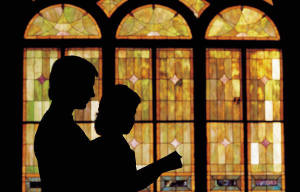‘On the day we call the day of the sun, all who dwell in the city or country gather in the same place. ‘The memoirs of the apostles and the writings of the prophets are read, as much as time permits. ‘When the reader has finished, he who presides over those gathered admonishes and challenges them to imitate these beautiful things. ‘Then we all rise together and offer prayers for ourselves… and for all others, wherever they may be, so that we may be found righteous by our life and actions, and faithful to the commandments, so as to obtain eternal salvation. ‘When the prayers are concluded we exchange the kiss. ‘Then someone brings bread and a cup of water and wine mixed together to him who presides over the brethren. ‘He takes them and offers praise and glory to the Father of the universe, through the name of the Son and of the Holy Spirit and for a considerable time he gives thanks (in Greek: eucharistian) that we have been judged worthy of these gifts. ‘When he has concluded the prayers and thanksgivings, all present give voice to an acclamation by saying: ‘Amen.’ ‘When he who presides has given thanks and the people have responded, those whom we call deacons give to those present the “eucharisted” bread, wine and water and take them to those who are absent.’
The above description of Mass was written by St Justin Martyr in c.155AD in a letter to the pagan emperor Antoninus Pius explaining what the Christians did when they gathered together for Mass. Though Jesus handed down the Sacraments and outline for his Church while he was still on earth, and Mass itself instituted at the Last Supper, it took considerable time after his Resurrection for the Apostles to explain and implement these teachings to the lay faithful.
However, historical accounts point to Mass being ‘established with readings, a sermon, the offertory, the prayers of the Sacrifice of the Mass, and Communion from the time of the Apostles. By AD 400 the liturgy could be very elaborate, and priests often celebrated Mass several times a week. Later they said Mass every day, and many lay people attended Mass daily.’ (Rasmussen, M.(2005) ‘The Catholic Church: the first 2000 years’ Ignatius Press pp 80).
So then, it is accurate to say that the liturgy we celebrate today is the same – save for a few tweaks here and there – as it was in the time of the Apostles. Masses were celebrated in Latin, because as the early Church became Catholic (universal) there was a need for unity in language throughout the various areas of the Church. This continued for centuries until the time of the Second Vatican Council. And were you today to celebrate Mass in the Vatican, it would be offered in Latin as that is still the official language of the Vatican state.
The Second Vatican Council was convened in 1962 by Pope John XXIII with a view to reforming the Church in order to meet the needs of the Twentieth Century. The Council brought about some radical changes to the aspects of the Mass – celebrating Mass in the language of the countries as opposed to Latin, with the lay faithful participating through responses; the removal of altar rails; and a change in the way that the priest faced when offering Mass, were just some of the reforms introduced at this time. And the idea of these reforms was to encourage greater participation of the lay faithful in the celebration of the Eucharist so that they could better come to understand the will of God in their lives and the life of the Church.
These changes were made so as to increase the reverence and holiness of the Body of Christ, the Catholic Church. Of course, these were only external changes. That is, the liturgy of the Mass was not altered and can still be described in the same way as that of the early Church: ‘Christians gathered together each Sunday to pray and sing hymns, read the Old Testament and Christian books such as the Gospels or the letters of the Apostles, listen to a sermon by the priest or bishop, and join in the celebration of the Eucharist’ (‘The Catholic Church: the first 2000 years’ pp 30).
Indeed, the Catechism of the Catholic Church explains that: ‘The liturgy of the Eucharist unfolds according to a fundamental structure which has been preserved throughout the centuries down to our own day. It displays two great parts that form a fundamental unity: ‘– the gathering, the liturgy of the Word, with readings, homily and general intercessions; ‘– the liturgy of the Eucharist, with the presentation of the bread and wine, the consecratory thanksgiving, and communion. ‘The liturgy of the Word and liturgy of the Eucharist together form “one single act of worship”; the Eucharistic table set for us is the table both of the Word of God and of the Body of the Lord.’ (Catechism of the Catholic Church 1346)
So each Sunday, or more often as is ideally the case, we join in a liturgy that is close to 2,000 years old and has been passed down from Jesus to the Apostles, and from their successors to today. Though our Churches and settings are perhaps more modern or vastly different technologically speaking than those of the early Church, the ritual of worship is still the same.
We gather to celebrate Mass, in its liturgies of the Word and the Eucharist, in the same way that the Apostles did. We experience Mass in the same way as the early Church and despite some changes over time, and perhaps some malpractice of the reforms of the Second Vatican Council, the Mass today is a ritual that traces all the way back to Christ, and the Last Supper.
Originally posted 2014-12-22 22:06:59.

